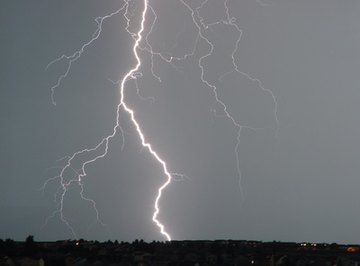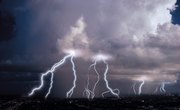
Thunder and lightning storms occur when warm, moist air rises quickly to form cumulonimbus clouds. The air and water in these clouds start rubbing against each other. This builds up electricity between the cloud and the ground, eventually resulting in a flash of lightning.
Cause
Thunder occurs when energy from lightning heats and rapidly expands the air. The resulting sound wave gets heard as thunder. While lightning and thunder occur at roughly the same time, lightning travels at the speed of light, or at 186,000 miles a second, while thunder travels at the speed of sound, equivalent to one-fifth of a mile in one second. People see the lightning long before they hear the thunder.
Measuring Distance
To determine the proximity of storm, count the seconds between the lightning flash and the thunder, then divide the number by five. The resulting number equals the distance in miles from the lightning strike. Lightning striking close by results in a loud, short bang of thunder, while lightning farther away produces long, low rumbles of thunder.
Lightning
Lightning occurs in thunderstorms and hurricanes, volcanic eruptions and even in heavy snowstorms. Lightning also shows up in extremely intense forest fires and surface nuclear detonations. A bolt of lightning heats the air to between 15,000 to 60,000 degrees Fahrenheit in a fraction of a second, or four times as hot as the surface of the sun. Each fork of lightning consists of two strikes. The first bolt heads downward, completing the circuit between the cloud and the ground. The second bolt occurs a split second later by going back up the same path.
Ground Flashes
Ground flashes occur naturally, because of normal electrification in the environment, or artificially, such as by strikes to tall buildings, airplanes and rockets. Artificial lightning goes from the ground to the cloud. Natural lightning goes the opposite direction, from the cloud to the ground.
Cloud Flashes
Cloud flashes include lightning that does not strike the ground. Instead, the lightning stays embedded in the cloud and shows up as sheet lightning or heat lightning. With heat lightning, the cloud remains too far away to hear the thunder associated with it, but thunder occurs just the same as any other lightning event.
Legend
Ancient peoples did not understand lightning in scientific terms. The Norse god of thunder, known as Thor, was depicted with a heavy hammer to represent the thunder coming down from the sky. Some Native Americans believed lightning and thunder came from the sacred thunderbird. The thunder came from the flapping of its wings, while the lightning came from its beak.
About the Author
Nancy Wagner is a marketing strategist and speaker who started writing in 1998. She writes business plans for startups and established companies and teaches marketing and promotional tactics at local workshops. Wagner's business and marketing articles have appeared in "Home Business Journal," "Nation’s Business," "Emerging Business" and "The Mortgage Press," among others. She holds a B.S. from Eastern Illinois University.
Photo Credits
Lightning image by Justin Pirtle from Fotolia.com
